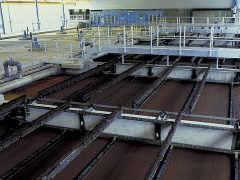Features
Making use of xylose
Date: 2019-10-28 15:20:31.0
Author: Jon Evans

Wastewater treatment plant.
Scientists are working hard to develop more efficient processes for producing biofuels from cellulose. But cellulose only comprises at most 50% of plant biomass, with hemicellulose the second most abundant biomolecule, accounting for up to 35%.
Whereas cellulose is broken down into glucose, which is readily fermented into ethanol by microbes such as yeast, hemicellulose is broken down into a different sugar molecule, xylose, which is much less readily fermented by yeast. This means that, at best, only half of plant biomass can currently be converted into biofuels, limiting the economics of the whole process. If the xylose could be utilized as well, then that would go a long way towards helping second-generation biofuels compete with fossil fuels.
Scientists have explored several ways to make this happen, including modifying yeast by genetic engineering and directed evolution. But while these approaches have basically worked, they haven’t yet resulted in a strain of yeast that can ferment xylose into ethanol at high enough rates for industrial production. This has inspired scientists to start exploring slightly different approaches.
One is to genetically engineer microbes to produce alcohols other than ethanol from xylose. For if a microbe needs to be modified to ferment xylose, then it might as well be modified to produce an alcohol with a higher energy density and better fuel properties than ethanol, such as butanol and isobutanol.
This is what a team of US scientists led by José Avalos at Princeton University has now done. As the scientists report in a paper in Biotechnology for Biofuels, they were able to develop a genetically engineered strain of the workhorse yeast Saccharomyces cerevisiae that could produce as much as 4g/L of butanol and isobutanol from xylose. This makes it 28 times more productive than previous yeast strains engineered for the same purpose.
Another approach is to find microbes that naturally ferment xylose and try to direct this fermentation so that it produces a useful product. For example, previous studies have shown that certain populations of anaerobic microbes can convert xylose into hydrogen when kept in the dark, through a process known as dark fermentation. This hydrogen could be used to generate electricity in fuel cells for powering cars and various other electrical devices.
The trick is to create populations of microbes that can do this as efficiently as possible, and now a team of researchers from Brazil and Canada, led by Gustavo Mockaitis at the University of Campinas, has found a simple way to do that.
As the researchers report in a paper in Renewable Energy, they first collected microbial populations from a wastewater treatment plant. Next, they exposed these populations to different pre-treatment processes, comprising acidic and thermal treatments alone and in combination, to try to encourage the growth of hydrogen-producing species. When they conducted dark fermentation with xylose on these populations, they found that the one exposed to the acidic pre-treatment performed best, able to produce hydrogen at a maximum rate of 253mL per hour.
Meanwhile, a team from Jiangsu University in China, led by Yang‐Chun Yong, has stumbled upon a way to make this dark fermentation process even more efficient. Yong and his team also started with a population of microbes taken from a wastewater treatment plant, but their aim was to identify a species in the population that could release electrons when grown on xylose, which led them to a yeast known as Cystobasidium slooffiae. As they report in a paper in the International Journal of Energy Research, their idea was to use this yeast in a microbial fuel cell, where it would break down xylose to produce electricity.
When they did this, however, they found that not only could the yeast generate electricity at a rate of a 67mW/m2, but simultaneously produced hydrogen at a rate of 23L/m3. It appears that the mirobes were releasing electrons as they fermented the xylose to hydrogen, offering two forms of energy for the price of one. This is on top of the two-for-one offered by being able to utilize both the xylose and glucose released from plant biomass.
The views represented here are solely those of the author and do not necessarily represent those of John Wiley and Sons, Ltd. or of the SCI.
Displaying 2 keywords used to tag this article:
- Jules Audemars-Australia Best Quali
- DG6582 Mens Moncler Down Jackets Gr
